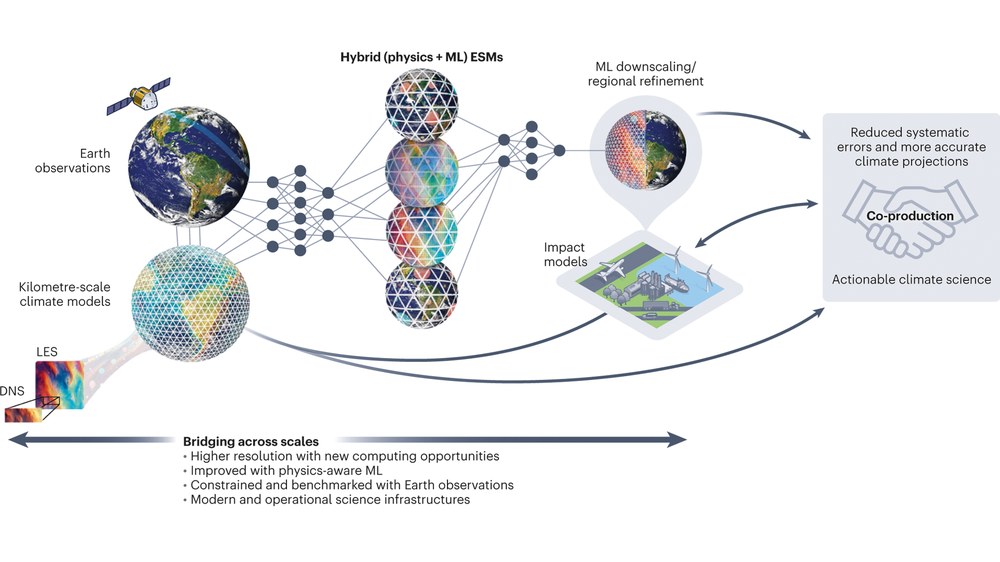Artificial intelligence and satellite data to improve climate projections

Eyring et al., Nature Geoscience (2024a)
- The aim is to significantly improve the accuracy and speed of predictions using machine learning methods.
- The new approach of the researchers combines models across different scales and varying complexity of processes with the systematic use of satellite data and AI.
- Focus: Spaceflight, Earth observation, AI
Satellite-based Earth observation data are fundamental to climate and environmental research. In addition to their essential role in monitoring the climate, they help to assess and evaluate climate and Earth system models. These models are important tools for providing climate projections and technology assessments for the sustainable development of individual sectors such as energy, aviation and transport. Artificial intelligence (AI) can help to further improve these models. A research team led by Prof. Veronika Eyring from the German Aerospace Center (Deutsches Zentrum für Luft- und Raumfahrt; DLR) and the University of Bremen has developed an approach for integrating AI into Earth system models, publishing two Nature 'Perspectives' on future research priorities. Machine learning methods are set to significantly improve the accuracy and speed of projections. This novel approach has the potential to reduce limitations of current climate models, leveraging the AI-revolution for this crucial research field. The perspective "AI-empowered next-generation multiscale climate modelling for mitigation and adaptation" on this topic was published in the Nature Geoscience journal on 25 September 2024.
Bridging differences, embracing strengths
Earth system models take into account important processes in the atmosphere and their interactions with other components of the Earth system (e.g., oceans and land), so they can make projections of the Earth system as a whole. Such models process large amounts of data and are limited in their spatial resolution due to computational requirements. This results in inaccuracies and systematic errors. Reducing these errors is one of the greatest challenges in climate modelling. The newly suggested approach uses machine learning techniques to improve the representation of processes that cannot explicitly be resolved in the models but are of central importance for climate dynamics. Simulations with high-resolution climate models – in the kilometre range – have higher accuracy when compared to observational data, but cannot currently be run at climate timescales for multiple decades or longer, due to their staggering computational costs.
The researchers' novel approach combines models across scales and process complexity with the systematic use of satellite data and AI. The AI works in a fully integrated way, for instance taking a climate model with very high spatial resolution in the kilometre range, learning the influence of a certain atmospheric process, and applying this learned AI model in the 'coarse' Earth system model, thereby making it more accurate. This is a groundbreaking solution that reveals the potential already contained in our existing data sets.
"Satellite-based Earth observation data are invaluable for climate and environmental research," says Eyring, lead author of the study from the DLR Institute of Atmospheric Physics. "We can and should use this resource much more intensively to calibrate, evaluate and improve global climate models. By combining AI with Earth system models and Earth observations, we will be able to project the complexity of Earth’s future climate and extreme events with unprecedented accuracy."
Redefining the traditional
The approach formulated by the collaborative research team from Germany, Spain and the US can also form a basis for more realistic 'digital twins' of the Earth system that are scalable, adaptable and user-interactive. Co-author Prof. Gustau Camps-Valls from the University of Valencia emphasizes the role of AI in this advancement, stating: "Integrating machine learning techniques with traditional climate modelling allows us to make substantial strides in understanding complex climate interactions and in improving the models. AI is not just assisting us. It is an essential part of redefining what our models can achieve."
The new publication marks a milestone in the development of climate models. AI-enhanced models will make it possible to project the impact of climate change with greater precision and improve technology assessments for individual sectors. High-resolution, global Earth observation data and improved, more accurate models are essential to develop strategies for reducing greenhouse gas emissions and to prepare society for the impacts of climate change. Co-author of the Nature Geoscience study, Dr. David Lawrence from the NSF National Center for Atmospheric Research, says, "Our proposed approach will allow us to simulate important Earth system processes with unprecedented accuracy, to become a crucial tool for planners and decision-makers worldwide." Co-authors of the Nature Geoscience Perspective also include Prof. Pierre Gentine from Columbia University and Prof. Markus Reichstein from the Max Planck Institute for Biogeochemistry. Prof. Veronika Eyring leads the European Research Council (ERC) Synergy Grant project "Understanding and Modelling the Earth System with Machine Learning (USMILE)" together with them and Prof. Gustau Camps-Valls.
The future machine learning
Machine learning is still a relatively new tool in environmental and climate research. With another international research team, DLR scientist Eyring investigated the challenges and opportunities that it presents. In an article published in the Nature Climate Change journal on 23 August 2024, the experts discuss how AI can help to further expand the boundaries of climate modelling and analysis. This includes the generalisation of methods in a changing climate, the quantification of uncertainties, explainable artificial intelligence, and causality. This is a distinctly interdisciplinary approach. Academia and the private sector from fields of machine learning, aeronautics, and Earth observation can work together to accelerate progress towards actionable climate science.
Related links
- Eyring, V., P. Gentine, G. Camps-Valls, D. M. Lawrence, and M. Reichstein, AI-empowered next-generation multiscale climate modelling for mitigation and adaptation, Nature Geoscience
- Eyring, V., W. D. Collins, P. Gentine et al., Pushing the frontiers in climate modelling and analysis with machine learning, Nature Climate Change
- European Research Council (ERC) Synergy Grant “Understanding and Modelling the Earth System with Machine Learning (USMILE)
